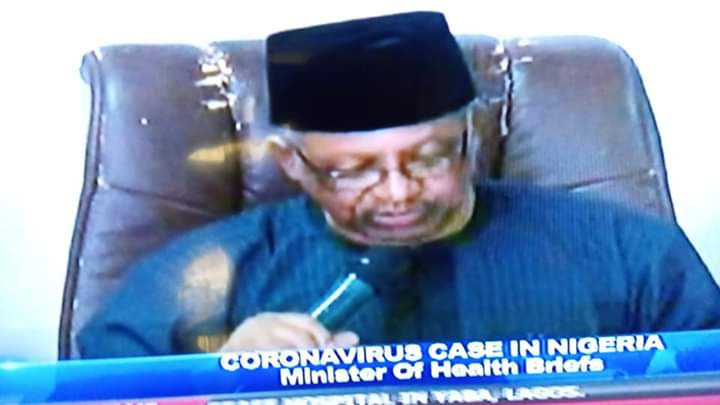For the critical importance of his message to Nigerian on Thursday last week in breaking the news that Coronavirus pandemic has arrived Nigeria, many did not give attention to the tears and observable worn-out of the official conference seat of the honourable Minister of Health of the Federal Republic of Nigeria, Dr. Osagie Enahire.
As soon as the picture of the seat went viral on social media Friday, 28 February 2020, till date, analysts have started tracing why such seat can be seen in the Minister’s official conference room.
Firing the first official shot on target was former boss of the Nigerian Electricity Regulatory Commission (NERC), Dr Sam Amadi, who x-rayed the presentation and tied it to the apparent level of Federal Government’s preparedness in handling Nigeria’s health concerns.
However, for us at Business Hilights, rather than criticising the seat, we felt it is important to review federal budgetary allocations to the health sector from 2018 to 2019 and 2020 to find out if the exposed wears and tears were truly institutional and representing the reality on ground at the nation’s health space.
Reviewing Nigeria’s health financing and government’s commitment since the beginning of the current administration, a trajectory of not adequately providing for universal health coverage of Nigerians is observed.
When the 2020 health budget is compared with that of the approved 2019 budget; it is observable that the Capital Expenditure dropped by 18.58 per cent from N57.09 billion in 2019 to N46.48 billion in 2020) while the Basic Health Care Fund dropped by -13.12 per cent (N51.22 billion in 2019 to N44.50 billion in 2020).
Another instance which shows that the priority of this administration is shifting away from healthcare is the fact that out of the three key development sectors (Security, Education, Health) of the country, health sectors got the lowest appropriation in the 2020 national budget. Clear reason why the Minister’s seat portrayed serious stress is the fact that the ministry had a meagre budget of N427.30 billion which is only 4.14 per cent of the proposed budget for 2020, while the Ministry of Education has 653.94 billion which represents 6.32 per cent of the total national budget. On the other hand, security and humanitarian affairs combined has N1.985 trillion which represents 19.23 per cent of the national budget.
The latter comprises of Ministry of Defence – N878.46 billion (8.5 per cent), Ministry of Humanitarian Affairs, Disaster Management and Social Development – N444.22 billion (4.30 per cent), Ministry of Police Affairs – N409.14 billion (3.96 per cent) and the Ministry of Interior – N254.81 billion (2.47 per cent).
Another fact to consider in not blaming the torn Minister’s seat is fallouts from how Nigeria is attending or implementing the Abuja Declaration on Health, adopted in April 2001 following the widespread shortfall in health budget by countries in Africa.
Recall that 19 years later, only about seven countries — Rwanda, Botswana, Niger, Zambia, Malawi, and Burkina Faso, Togo — have met the Abuja target, but Nigeria is still nowhere to be found.
The most embarrassing is that Nigeria that hosted the conference has never voted more than six per cent of its annual budget to the health sector.
The highest percentage since the declaration was in 2012 when 5.95 per cent of the budget was allocated to health.
A very closer review of the 2020 Federal Government health budget showed that the government apparently deemed it fit that N2,000 would be enough in the year 2020 to provide for the healthcare of each of the estimated 200 million Nigerian.
This is according to the meagre N427.3 billion proposed for Healthcare in the proposed 2020 national budget.
Analysts say what this means is that there may be more torn seats and several depreciated health infrastructure across the federation if we want tell ourselves the bitter truth.

Additionally, it means the salaries of all health workers in the Ministry of Health, the fuelling of the ambulances and the generating plants, the rehabilitation and or construction of new hospitals, the drugs for Malaria, Polio, Child Vaccination, Tuberculosis, Meningitis, HIV/AIDS and of course cancer diagnosis machines are all part of the budgeted amount. The list continues to even health research, training and health promotion.
Business Hilights recalls that earlier in 2018, key stakeholders in the health sectors gathered at an event declared open by the representative of the Vice President to discuss the crisis of universal health coverage in the country.
At the event organised by PREMIUM TIMES, Chiedo Nwankwo, a health and gender expert, stressed that Nigeria had failed to properly fund the health sector using the country’s failure to meet the 15 per cent benchmark agreed upon in the Abuja Declaration of 2001.
Taking a serious look at Nigeria’s Healthcare Indices, many provide context to how dire the situation is in the country.
According to the World Health Organisation, Nigeria is “the country where nearly 20 per cent of all global maternal deaths happen. Between 2005 and 2015, it is estimated that over 600,000 maternal deaths and no less than 900,000 maternal near-miss cases occurred in the country”. Overall, the maternal mortality rate is approximately 800 per 1000 live births and 58000 maternal deaths in 2015.
Also, only 61per cent of pregnant women have access to antenatal services, according to the HealthCare for Women International and Relief Web while Trading Economics puts birth attended by skilled health staff by. 2014 at 35 per cent.
The picture looks grimmer when UNICEF says that 4.3 Million Children still miss out of immunizations every year and Trading Economics puts the neonatal mortality rate at 34.7 per 1000 live births in 2015. Also, Nigeria Malaria Factsheet estimates that there are over 300,000 malaria deaths per year with 100 million cases. This is besides the fact that Malaria contributes to an 11 per cent mortality rate in Nigeria.
Furthermore, reported cases of Meningococcal disease by WHO as of March 2017 is a total of 1407 with 211 cases resulting in deaths, although the Nigeria Center for Disease Control (NCDC) puts the number of reported cases at 914.
Global Polio Eradication Initiative puts reported cases of poliomyelitis in Nigeria at 13 in 2019 and 34 in the year 2018.
Accordingly, that trending picture of the Minister’s torn and worn-out seat is not standing alone in the apparent decay and backwardness in the ministry’s performances nationwide when facts and figures are reviewed.








